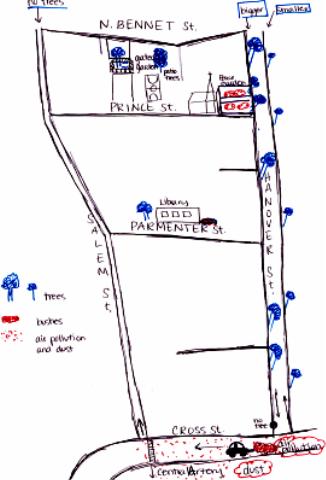The North End isn't exactly an urban wild. One of the earlier settlements in Boston, trees and other greenery have not been a part of the streetscape since the 1700s most likely, so I was curious to take a closer look for the more natural (i.e. green) side of the North End. I would like to say that I found some hidden oases in back alleys, but there were not any. I did, however, find, yet again, another area in which to contrast Salem and Hanover streets. Perhaps influenced again by their historical development, the two streets developed different green space.
Topography and History
The topography of the land influenced early development in the North End. The Old North Church, located on Salem St., is significant in both the history of the United States and the North End. Though I could not find a historical map showing it explicitly, the church is located on a slight hill, at a higher elevation than surrounding buildings. This was often a position reserved for churches, as they were and are an important part of communities. Perhaps the location of the hill and church also contributed to the development of Salem St. as a residential area; you wouldn't generally expect a church to be located in a busy commercial area.
The placement of the commercial district was also influenced by its proximity to the harbor, the mills, and the street (Middle Street, now Hanover) connecting it to downtown. The open harbor on one side of the North End provided a place for trading goods, both those imported to and exported from other ports and countries and those that were taken form the ocean. The ocean was, obviously, important in the settlement and development of the area.
In addition, the man-made pond on the other side of the peninsula contributed to the development of the North End. After it was damned, it provided both jobs and goods for the residents of Boston through the many mills and factories located on its shores. Though it was not a naturally occurring body of water (though, of course, the ocean that fed it was), it proved important in the lives of North End residents.
Although no direct signs of its influence exist today, the Mill Creek probably greatly influenced the development of my site in its role as a mode of transportation for the mills. Sending goods by boat along this route to the ports and wharves on the other side would have been much faster and safer than sending them all the way around the peninsula. Mill Creek also bordered the far end of my site, preventing further continuous residential development into downtown Boston. It provided a physical barrier, lending to the development of the North End as an eventual ethnic enclave I imagine. At the same time, it is difficult to judge the influence of Mill Creek since the Central Artery separates the North End from where Mill Creek used to be located (before it was buried), so it is difficult to distinguish between the effect of nature, in the Mill Creek, and that of man, in the Central Artery.
next
